Exerting Control
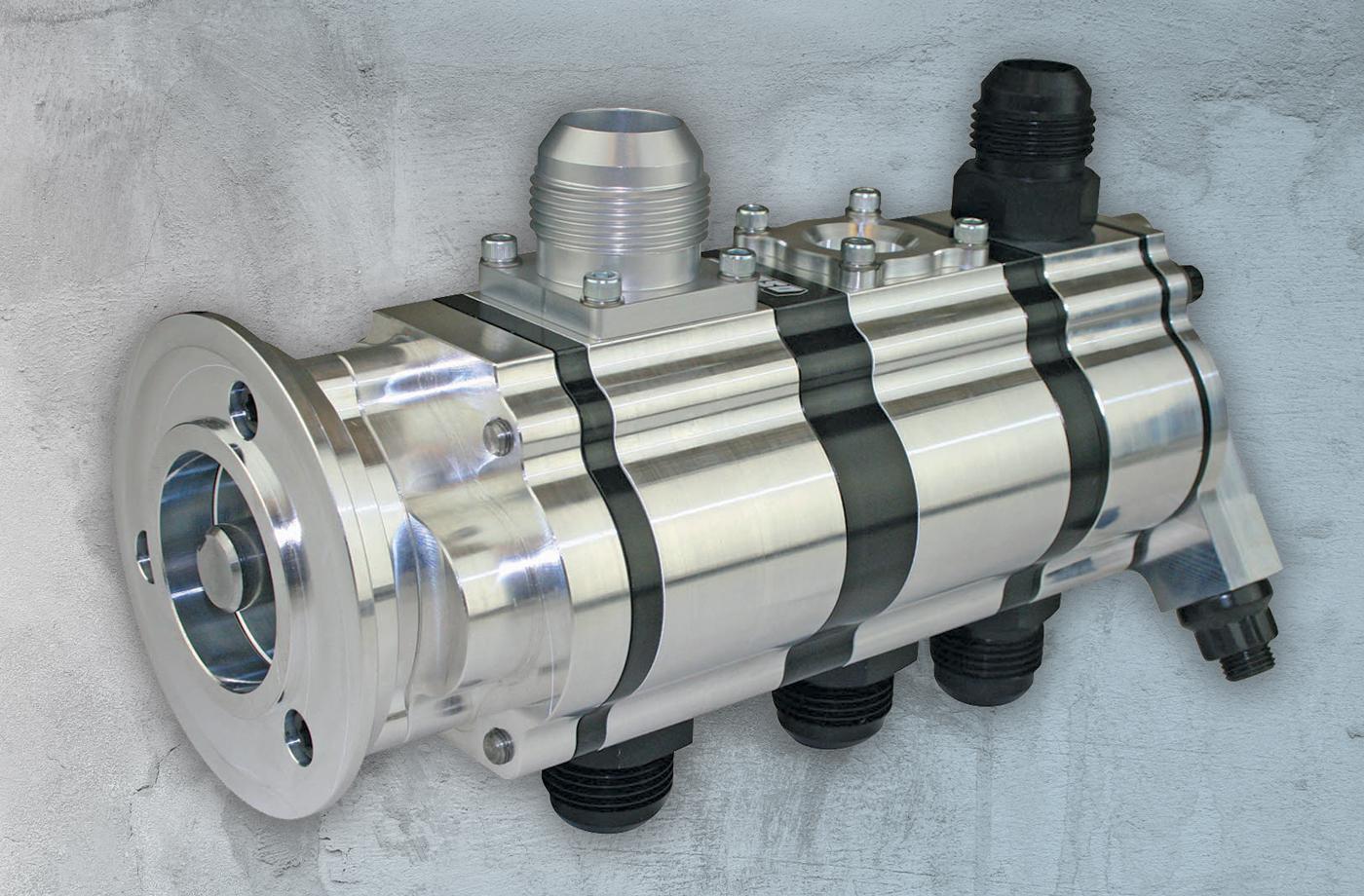
Oil system manufacturers are constantly updating and upgrading this most fundamental aspect of an engine’s operation in order to prevent the (potentially disastrous) consequences of inadequate oiling.
Engines, in one form or another, have been around for a very long time. So, it would seem that by now something as fundamental to the engine’s function as its lubrication system would be dialed in. Yet there are forces at work that keep an optimized oiling system a constantly moving target, from ever-thinner oils to ever-more-powerful engines. Plus, basic fluid dynamics keep system developers on their toes.
“Oil is the only thing in the engine that’s completely footloose and fancy free to go wherever it wants,” said John Schwarz of Aviaid Oil Systems, Chatsworth, California. “Where the oil goes is impacted by what a vehicle is doing. In drag racing, it all goes to the back of the pan, or the back of the valley, or the back of the cylinder head. In road racing, it goes to the front of the pan, the back of the pan, the left side of the pan, the right side of the pan. In circle track racing it typically goes to the right side of the pan. In hydroplane racing, it goes to the wrong side of the pan. Those boats still turn left, but the engine is in the boat backwards, and centrifugal forces in a 2G turn can be so significant that it will overcome the windage and crankcase to drive the oil to the side of the pan where the pickups typically are not placed.”
Oil, Schwarz said, “is the one thing in an engine that’s completely uncontrolled. The better you can control it, the better the system will operate overall.”
Oil Capacity
The foundation of an oiling system, the oil pan, has been reengineered to work with some of today’s most popular engine families.
“One of the biggest things we deal with is how LS engines fit in cars,” said Scott Hall of Moroso, Guilford, Connecticut. “The reason it’s so much trickier than other engines is because, while most blocks have the oil pan rail at the centerline of the crankshaft, an LS has a skirted block, which takes away some of the oil pan capacity. We have to build a variety of oil pan sizes for LS engines to fit into everything from a COPO Camaro to a road racing car or a sand rail.
“The key factors we always look at with any type of oil pan are, how much oil are we looking to get into it, and how does the crank centerline of the engine relate to the lowest point of the car?” Hall added.
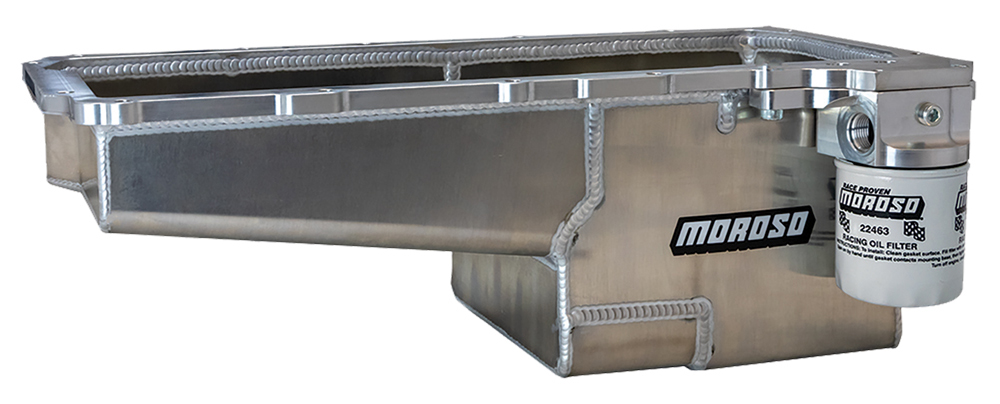
With a traditional engine block “you could put an oil pan on there with a kick-out pouch to get some of the oil off the rotating assembly,” added Moroso’s Frank Thibodeau. “That would help free up some windage and get the engine to spin a little faster. But we can’t do that in an LS because the crank is recessed into the block. It’s very similar to the old Hemi motors. In those situations we try to control the oil the best we can with the maximum depth we can put in there, since getting the oil away from the rotating assembly will help. We also build features into the pan, like windage trays and scrapers, to help control the oil and keep it off the rotating assembly as much as possible.”
Another design Moroso uses for these engines is a T-sump pan, “where the sump is wider than the width of the pan,” Hall explained. “We’re trying to find the capacity needed so these pans will fit in the envelope we’re given.”
Oil Control
Yet even the most carefully designed and constructed pan can’t do its job properly if the oil isn’t getting to it.
“One problem we run across quite often in the drag race and truck pull markets is customers not having enough oil to go from A to B,” said Mark Mittel of System 1 Filtration Products, Tulare, California. “The inherent problem is that the right-hand valve cover is full of oil that can’t get back to the sump. It’s draining back through the heads, but then when it’s trying to return to the pan, it falls on top of a rotating mass that flings it right back up again. It’s a tough situation to get enough oil back in the pan to make the complete run or the complete pull.” The situation is more pronounced in the right-side valve cover because “that’s the way the crank and rods are turning,” Mittel explained. “It flings the oil back up on the 2-4-6-8 side of the motor.” Some racers overfill the crankcase as a way to mitigate the problem, but the excess oil can create “a horsepower-robbing situation.”
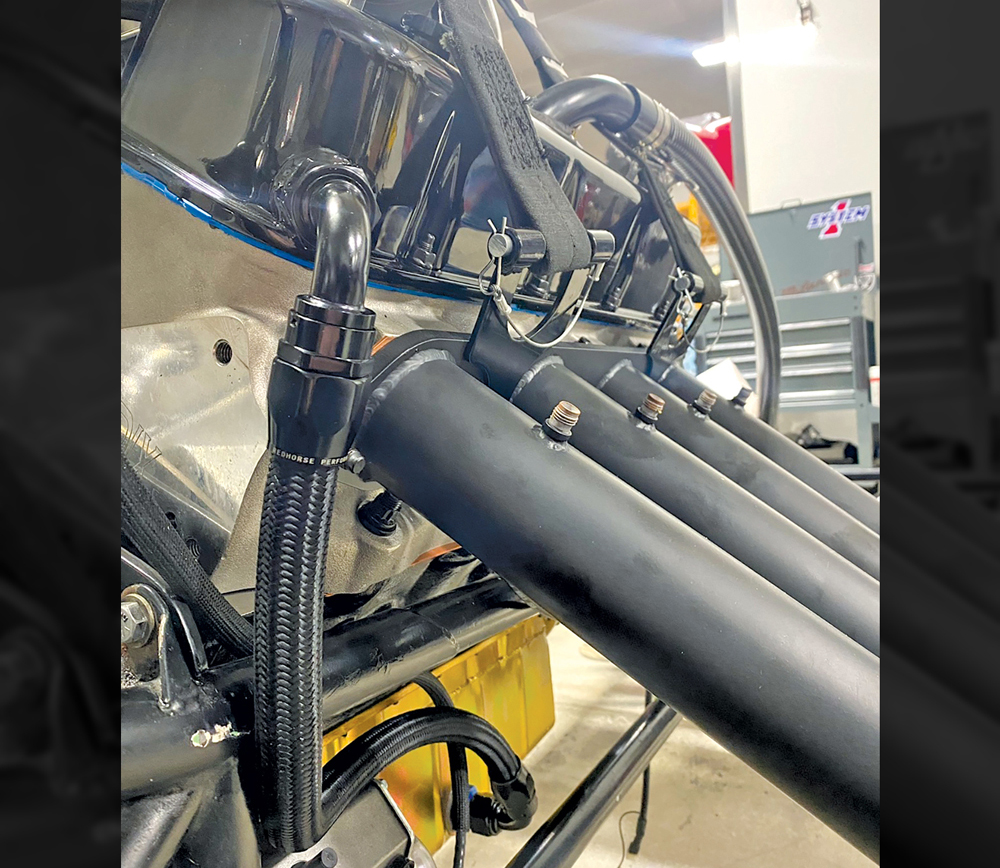
Mittel’s solution is to install a drain from the back of the valve cover to the oil pan. He recommends using hose “that’s a minimum of a -12 AN, though a -16 is preferred.” The line needs to be plumbed so that “the oil returns underneath the windage tray, because that’s more of a low-pressure area, versus the high-pressure area right next to the spinning crankshaft.” This has worked for “many, many customers,” he added, “especially the Bonneville guys. They have to run a full five miles dealing with oil. This can also help in a Funny Car or an Altered, where you can’t put a very big pan under it. Now they can carry the right amount of oil, and it pretty much ensures the oil goes all the way back to the oil pan.”
Another way to address this situation is to plumb an oil accumulator into the system, Mittel said, “especially with some of these cars where you can’t put a big pan on. If your oil pressure drops below a certain level—whatever pressure you set on the accumulator—it will turn on, and here comes two or three more quarts of oil to feed the motor.”
The Dry Sump Solution
A dry sump oiling system will solve many of these oil control problems because it allows the placement of oil pickups “in places where oil is accumulating, not necessarily in the center of the pan where you’re trying to have a one-size-fits-all kind of pickup,” said Schwarz. “Chrysler Hemis, for example, have a real tendency to pack oil in the valve covers. With a dry sump you have the ability to add scavenge sections specifically for the purpose of scavenging the cylinder heads and getting the oil back to the tank where it belongs.” There is also flexibility in where the sump tank is mounted for a weight placement advantage, he added.
For race vehicles subjected to high G forces, “like a rock climber that goes up steep hills, oil control is a problem,” said Mike Cofini of Clear View Filtration, Spokane, Washington. “A dry sump works better for those type of applications. It’s the same thing on a drag race car. When you throw the parachutes out, oil pressure can drop or could go to zero because all the oil gets thrown to the front of the motor and away from the pickup screen.”
“Anybody who can afford a dry sump should put it in their car, because it’s the best oiling system you can have,” said Thibodeau. “There’s a reason every serious race car in the world has a dry sump.”
To Hall, the “biggest advantage” of a dry sump system is that its shallow oil pan “allows you to have the engine far lower in the car than you would normally have with a wet sump system.” For an LS engine, Moroso makes a dry sump pan that’s 4 inches deep, compared to a standard pan that’s 6–6.5 inches deep, “so you’re gaining 2–2.5 inches of lower center of gravity by going with a dry sump system. That’s a real benefit.”
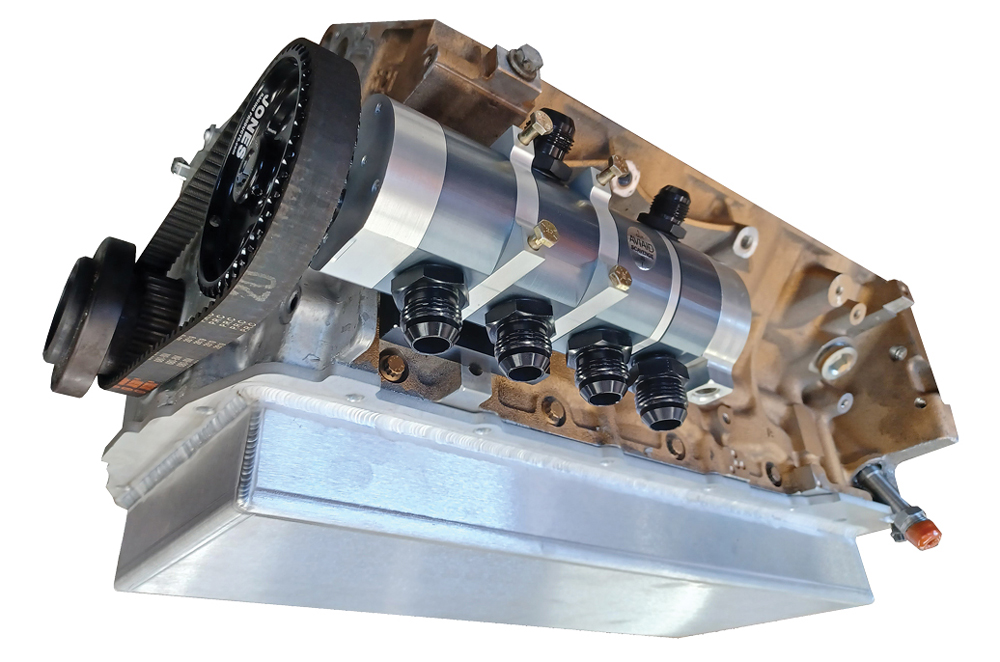
Oil capacity is another reason to run a dry sump system. “In a Funny Car or alcohol Funny Car, there’s only about 4 inches of pan clearance, and in such a small pan you can’t have 10–12 quarts of oil,” said Cofini. “Because the pan is so close to the ground, or because of other chassis components, there’s not room for very much oil in there.”
“With a dry sump system, you can put five gallons of oil in a car,” Schwarz added, “and with that higher capacity, the engine will be circulating cooler, cleaner oil. You can’t do that with a wet sump, especially because nine times out of 10, even with the older engines everything’s getting lower to the ground. Nobody wants to run a high center of gravity. So the first question we get asked a lot of the time is, ‘How shallow an oil pan can we put in this thing?’
“There’s nothing that a dry sump system can’t help improve with regard to an engine,” Schwarz said.
“Dry sump usage and popularity have never been this strong,” said Thibodeau. “We are selling more dry sump pumps than we ever had as a company. In the 34 years I’ve been at Moroso, dry sumps were typically confined to drag racing and higher levels of circle track, but now you’re seeing them at all kinds of different levels of drag racing. A lot of different racers are using dry sumps. So now we’re making them for so many different applications. We make them with a V-band clamp on the front so it can be put on the front of a centrifugal supercharger drive mount. For LS motors, we took the bolt pattern on the block that was used for an A/C compressor—which is not used on a race car—to develop an adapter to bolt the dry sump to the block.”
This “explosion of dry sump pumps in our industry,” as Thibodeau called it, has brought with it “a bigger need for different types of pressure section widths, depending on the volume needed for these dry sump pumps. Not every one of them will need the same amount of volume to support that motor. So we have five different pressure width options to accommodate the specific types of needs a motor would require.”
On the subject of dry sump oil pressure, Cofini pointed out that “it’s virtually impossible to suck oil through the same size line as you’re putting 80–90 pounds of pressure out the other side. You should be using the next size up line to suck out of a dry sump tank as you’re pushing through the other side.” Testing on a flow bench demonstrated to him that “it’s only a matter of time before it starts not sucking the correct amount of oil through there and creates a vacuum, which will reduce the oil pressure and the volume going through it.” So with an LS engine, for example, “if you’re sucking through a number 12 line and pushing through a number 10 line, everything’s great.”
Dry Sump Alternatives
If a dry sump system doesn’t fit a racer’s budget, there are lower-cost alternatives.
“One option is an external wet sump pump, which is a belt-driven, single-stage pump,” said Hall. “It allows you to build a shallower wet sump pan and have the pump outside.” He called this setup “a big option for all the COPO Camaros when the NHRA allowed them to go to an external wet sump pump,” and he said it’s also popular “with Ford and LS guys. Instead of the oil pickup going the entire distance of the pan and getting in the way of the rotating assembly, now the pickup’s in the rear, the pump’s outside, you can prime the pump, the pump doesn’t get hot, and now you can do more with larger strokes and use the shallower versions of wet sump pans.”
“A wet sump oil pump with a dry sump attitude” is how Verne Schumann of Schumann’s Sales & Service in Blue Grass, Iowa, describes his ER-VAC oiling system. The ER stands for energy recovery. As Schumann explained, “The bypass oil never sees the pan again. It goes back through a re-routing high-pressure hose to the pickup tube, and we re-pressurize the intake tube,” promoting additional oil flow no matter the orientation of the oil in the pan. VAC stands for vacuum; the ER-VAC system is a closed-loop system not vented to the outside air. It’s similar to when a drag racer “introduces a vacuum pump to suck the oil pan into a vacuum reading, which gives you horsepower,” Schumann said.
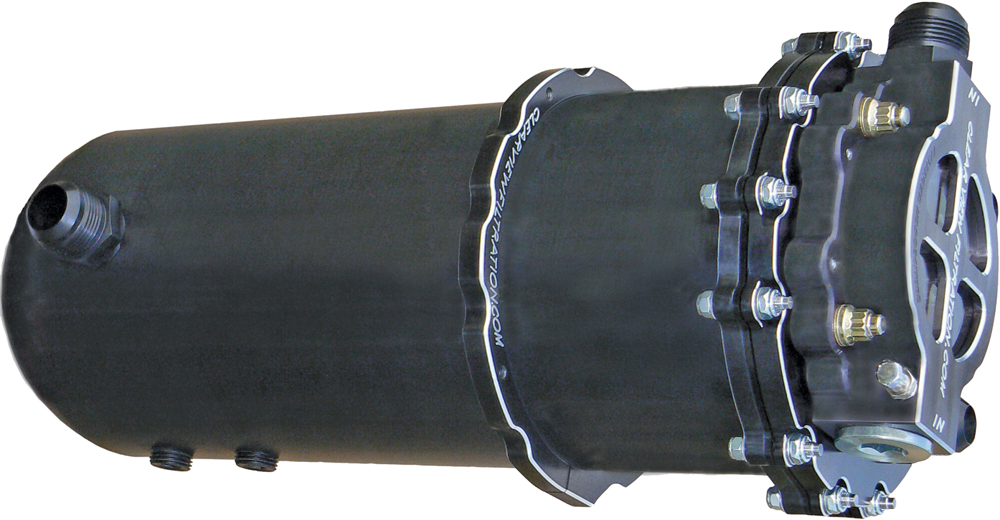
The ER-VAC system works well in many racing environments, but where it really “dominates,” Schumann said, is in monster truck competition. “They stand the truck on its nose for 6, 8, 10 seconds before it drops down, because the longer they stand on the nose the more points they score. But with a conventional oiling system, when the truck is on its nose, all the oil in the pan runs to the front of the motor, and the pickup, usually in the back of the motor, is now sucking air.” With the ER-VAC system in place, “the trucks can sit there for 10–15 seconds before they drop down on the ground and it doesn’t hurt the motor. We forcefully pipe the oil back to the intake stream and pressurize the intake side of the pump. So if the bypass oil is set at 60 psi, it’s going to go in the intake at 60 psi. And guess what else does that? A dry sump, for big dollars.” Schumann quoted prices for dry sump systems as “$3,000–$7,000 installed; our pumps run from $300–$500. Is it as good as a dry sump? No. But if the rules say wet sump only, we’re a killer item.”
Proper Pressure & Volume
“So many people call me with bearing problems,” said Cofini, who spent 30 years as an engine builder before starting his business making see-through oil filters. “I tell them they need to have more oil pressure, especially in boosted applications, because we’re using that oil pressure as a shock absorber between the connecting rod and the bearings. When these turbo cars make 30–40 pounds of boost, we’ve already squished the oil out of the bearing.” On such an “extreme application,” Cofini recommends “a minimum of 10 pounds per 1,000 rpm. I even like to see 12 or 13 pounds for every 1,000 rpm, especially if you’re running the motor up over 9,500, which a lot of guys do now.”
The popularity of drag-and-drive events like Drag Week and Sick Week has complicated oil pressure recommendations, Hall said. “You have to have enough oil pump in the thing to keep the race car side happy, but at the same time you don’t need to make 150 pounds of oil pressure driving down the road. But when you’re at the track, there’s a balance you need to achieve. A street car making 20 pounds of oil pressure at a stoplight is okay, but in a large-cubic-inch engine, something with huge valve springs and overlap, you have to be careful that there’s a balance of oil viscosities and oil pump sizes.”
Schumann has a new product “just around the corner” called DialAdjust that will enable the driver to adjust oil pressure at the turn of a knob. “Let’s say in a circle track application, during qualifying the driver can turn down the oil pressure for one lap to make a better horsepower rating,” Schumann said. “Later in the race, say at lap 70 or 80 of a 100-lap race, when the oil is getting hotter and more contaminated and the oil pressure is dropping, he can crank it up again.”
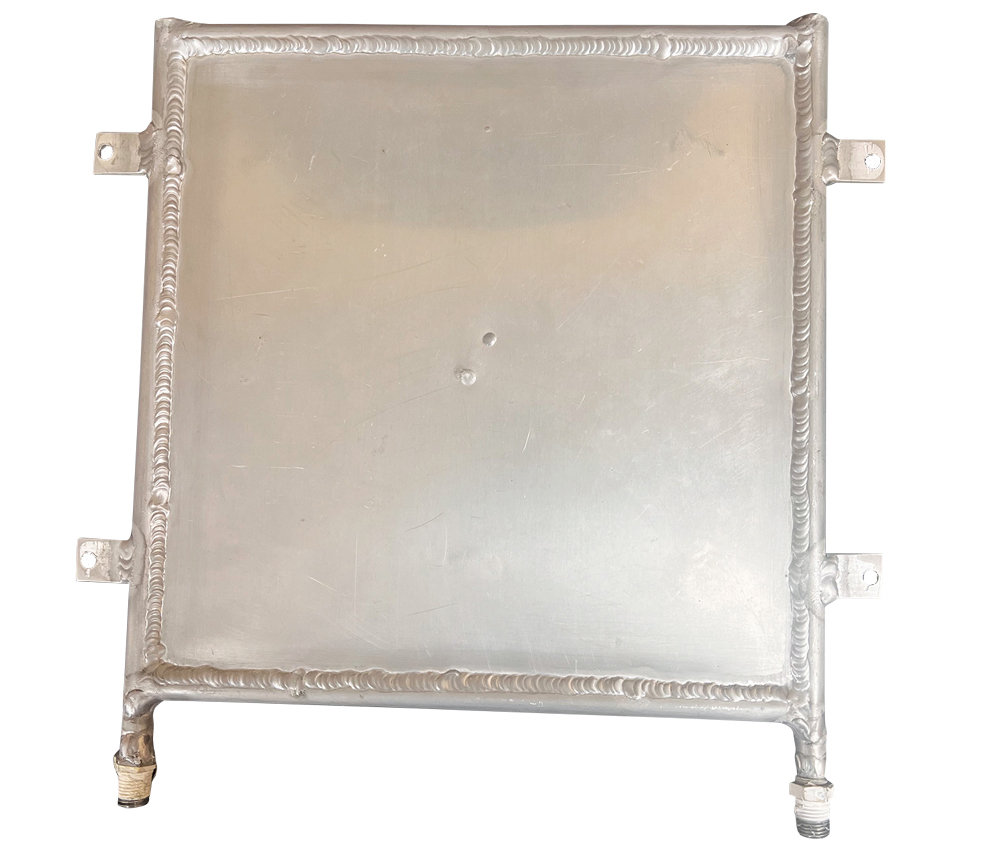
The DialAdjust system will be available for “all engine families,” Schumann said, and will require no internal engine modifications. “We’ll pick up the oil for the transition and control the pressure through the oil pump filter area, and then pump it back into the pan. Adjustability will be by two means: Both the volumetric gallons per minute and the pressure will be controlled. The two always work hand-in-hand.”
Oil volume is a critical part of the oiling system that can be misunderstood, Cofini believes. He’s seen it in questions from customers about the size of the oil filter a particular application should run.
“The biggest thing that makes the filter assembly different is the type of engine and how big the oil passage feed hole is going into the motor,” he said. “Horsepower has nothing to do with it. Some people think that the more horsepower you make, the bigger the filter you need, but that’s not true. For example, a Ford has a half-inch feed hole in the block, so at 90 pounds of pressure, it can only run about 12 gallons a minute through that hole. That hole dictates the entire system.
“We have also learned how important the inside of a fitting is to our oil system,” Cofini added. “Take a block adapter for a big block Chevy. The big block has a .600 feed hole on the block. If you put a number 10 line on that, which is a half-inch hole, you’ve restricted oil to the engine. You could have an oil pump the size of a dump truck and a four-inch hose feeding your motor, but if it has to run through a half-inch hole at 80 pounds of pressure, that’s all the volume you get to the entire motor.”
Also important when choosing an oil filter is to match the weight of the oil with the filter material. “One of the problems we have is somebody trying to run too fine of a filter with too heavy of an oil,” said Mittel. “It can cut the flow rate by a third at least, or half.” For a drag racer or tractor puller running straight 60- or 70-weight oil, for example, “for 99% of the applications we would steer them to a 75-micron element. Some companies have a 75-, 80-, even a 100-micron filter, but you can reach a point of no return. If the diameter of the holes in the filter are too big, it’s like not having a filter at all.”
Mittel also pointed out that while blending a straight-weight oil with an oil additive can improve the oil’s lubricating properties—“all the added zinc and phosphorous are your friends”—it will also raise the oil’s thickness. So a straight 50 can become a 60, which may then be too thick for the filter. “And if they’re using a traditional paper-style filter on there, more than likely it will tear the paper inside the filter to let it flow. In most cases the racer never knows that it’s torn a hole in the paper, so they’re not getting any filtration at all. So always be mindful of the other side of the filter.”
Sources
Aviaid Oil Systems
aviaid.com
Clear View Filtration
seethroughfilter.com
Moroso
moroso.com
Schumann’s Sales & Service
schumannssalesandservice.com
System 1 Filtration Products
system1filters.com
 MEMBERSHIP LOGIN
MEMBERSHIP LOGIN JOIN PRI
JOIN PRI


